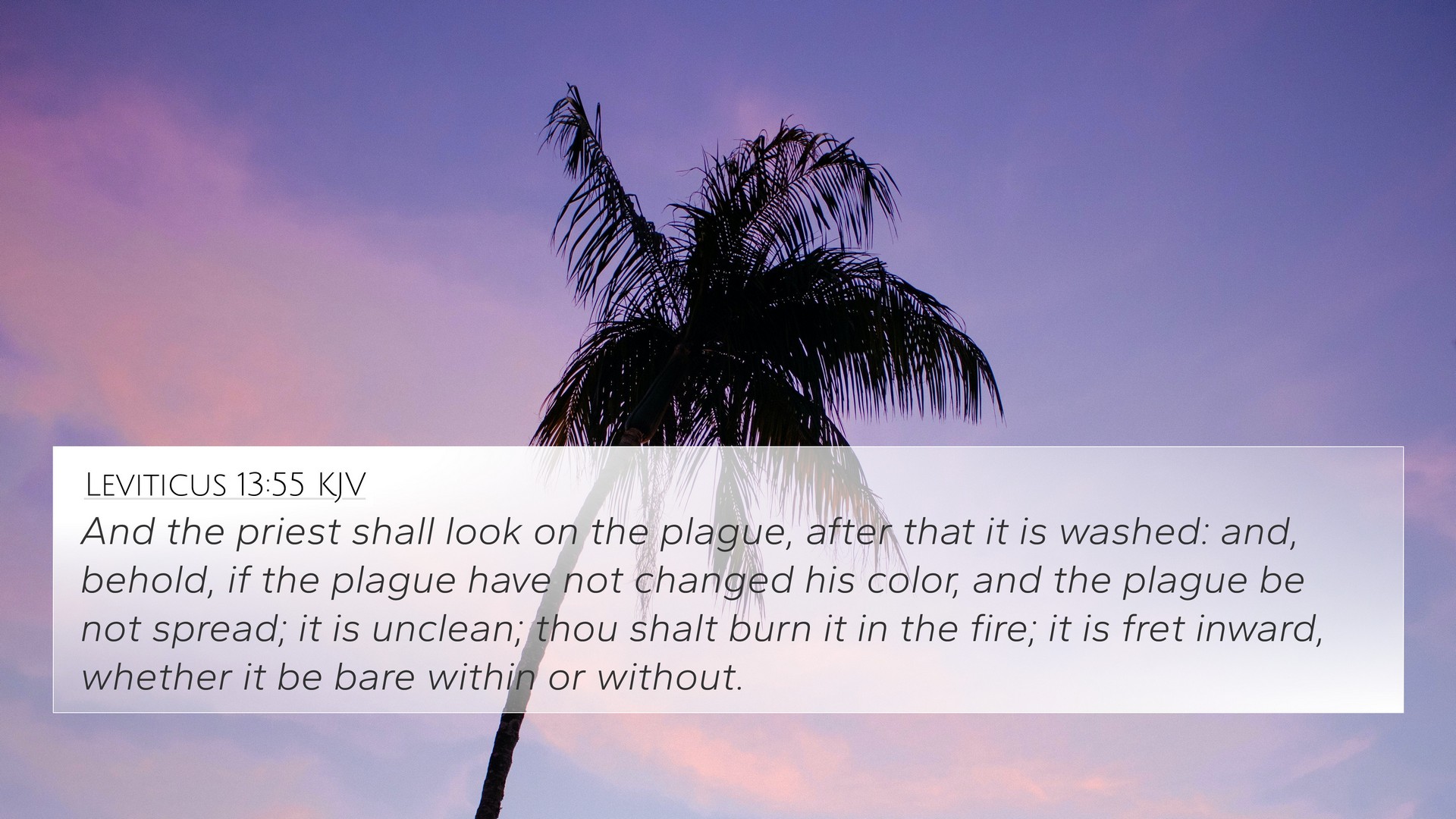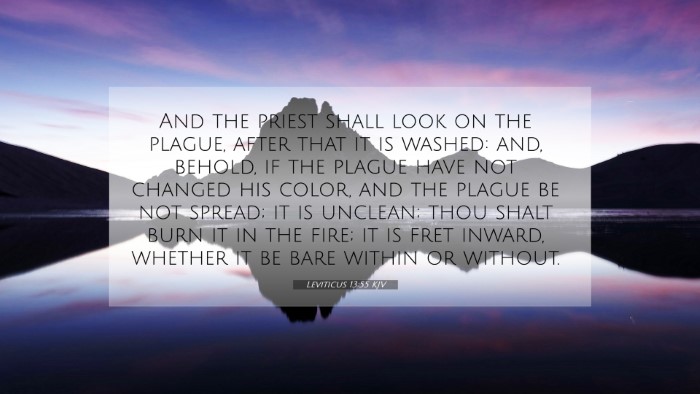Understanding Leviticus 13:55
Verse: Leviticus 13:55 - "And if the priest sees that the plague of the leprosy is not spread in the garment, either in the warp, or in the woof, or in any thing of skin; it is a plague of leprosy: it shall be shod and burned."
Context and Overview
The book of Leviticus serves as a detailed guide for the Israelites regarding holiness, cleanliness, and the laws pertaining to ceremonial purity. Chapter 13 deals specifically with the diagnosis of leprosy, a condition that could affect both people and garments. The focus of this verse is on the inspection of garments for signs of this disease.
Interpretative Insights from Public Domain Commentaries
Matthew Henry: Henry emphasizes the severity of leprosy, underscoring that it symbolizes sin and spiritual decay. He notes that the priest’s examination serves as a cautionary procedure, reflecting the spiritual state of God’s people. When a garment is found to have a plague, it signifies God's judgment; thus, it should be destroyed. This serves as a grave reminder of the consequences of sin.
Albert Barnes: Barnes provides a practical understanding of the behavior prescribed in this verse. He explains that the priest’s decision to burn the affected garment reflects ancient practices of maintaining purity within the community. According to Barnes, leprosy in garments may indicate broader spiritual corruption, and its elimination signifies God's desire for holiness among His people.
Adam Clarke: Clarke expands on the implications of leprosy as more than just a physical ailment. He highlights that this regulation addresses the community's health and moral integrity. Clarke interprets the act of burning the garment as a commitment to purity and a reminder of the severe consequences of turning away from God's laws. This punishment indicates how seriously God views spiritual integrity within the community.
Thematic Connections
This verse, while specific to physical leprosy in garments, offers profound insights into God's expectations for His people regarding holiness and the consequences of sin. The underlying thematic connections include:
- Holiness and Purity: Leviticus emphasizes that God's people must maintain both physical and spiritual purity.
- Sin and Judgment: The treatment of leprosy symbolizes the effects of sin, which, if unchecked, would lead to spiritual decay.
- Community Welfare: The regulations around leprosy serve to protect the community from contamination, highlighting the collective responsibility to uphold God's standards.
Cross-References to Leviticus 13:55
The following verses provide additional insights and cross-references that enhance our understanding of Leviticus 13:55:
- Leviticus 14:34: Discusses the inspection of a house for leprous plague, demonstrating a similar concern for purity.
- Deuteronomy 24:8: Addresses the laws regarding leprosy and emphasizes the need for careful examination to prevent contamination.
- Isaiah 1:18: "Come now, and let us reason together..." indicates the call to spiritual cleansing and restoration, paralleling purity themes.
- Matthew 8:3: Jesus heals a leper, fulfilling the law's requirements while demonstrating compassion, linking New Testament healing to Old Testament laws.
- Hebrews 13:12: Talks about the sacrifice of Christ outside the camp, relating to the idea of burning unclean items, symbolizing the ultimate removal of sin.
- James 4:8: "Draw near to God..." which encourages believers to seek purity and draw closer to God, reminiscent of the holiness required in Leviticus.
- 1 Peter 1:16: "Be ye holy; for I am holy," reinforcing the call for God’s people to reflect His holiness, akin to the teachings in Leviticus.
Applications and Lessons Learned
The teachings of Leviticus 13:55 invite reflections on contemporary spiritual practices:
- Self-examination: Believers should regularly examine their lives for anything that may lead to spiritual impurity, paralleling the priest's role in assessing leprosy.
- Community Responsibility: Upholding standards of purity within the community fosters an environment where faith can thrive.
- The Importance of Repentance: Just as leprous garments were destroyed, believers are called to eliminate sin from their lives, pursuing genuine repentance.
- Christ's Redemptive Work: Understanding the significance of Jesus' actions helps believers appreciate the transition from the old law to grace, revealing God's desire for spiritual healing.
Further Study and Cross-Referencing Techniques
To delve deeper into this verse and its implications, engaging in cross-referencing can be highly beneficial:
- Using a Bible Concordance: Helps in identifying themes and words that connect different Scriptures.
- Bible Reference Resources: Utilize guides that explain the connections between verses for comprehensive understanding.
- Cross-reference Bible Study Methods: By using a systematic approach, believers can discover deeper meanings and thematic links throughout the Bible.
- Comparative Bible Verse Analysis: Look at parallel verses to understand the variety of teachings and contexts in which they occur.
- Identifying Connections: Investigate how Old Testament laws transition into New Testament teachings to grasp the story of salvation in its entirety.
Conclusion
Leviticus 13:55 serves as a reminder of God's holiness and the importance of maintaining purity in our lives. Its implications stretch beyond physical cleanliness to spiritual integrity, urging believers to reflect on their relationship with God and the community. By engaging in cross-referencing and deeper studies, one can uncover profound truths that resonate throughout Scripture, building a more robust faith and understanding of God’s word.






